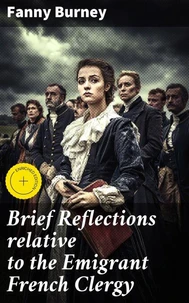Camilla; or, A Picture of Youth. Exploring Love, Society, and Expectations in 18th - Century England
Par :Formats :
Disponible dans votre compte client Decitre ou Furet du Nord dès validation de votre commande. Le format ePub est :
- Compatible avec une lecture sur My Vivlio (smartphone, tablette, ordinateur)
- Compatible avec une lecture sur liseuses Vivlio
- Pour les liseuses autres que Vivlio, vous devez utiliser le logiciel Adobe Digital Edition. Non compatible avec la lecture sur les liseuses Kindle, Remarkable et Sony
 , qui est-ce ?
, qui est-ce ?Notre partenaire de plateforme de lecture numérique où vous retrouverez l'ensemble de vos ebooks gratuitement
Pour en savoir plus sur nos ebooks, consultez notre aide en ligne ici
- Nombre de pages825
- FormatePub
- ISBN4057664650924
- EAN4057664650924
- Date de parution21/11/2019
- Protection num.Digital Watermarking
- Taille1 Mo
- Infos supplémentairesepub
- ÉditeurGOOD PRESS
Résumé
In "Camilla; or, A Picture of Youth, " Fanny Burney presents a richly woven tapestry of late 18th-century society through the eyes of its spirited heroine, Camilla. This novel, characterized by its intricate characterizations and sharp societal observations, delves into themes of love, morality, and personal growth, all while employing Burney's distinctive epistolary style. Set against the backdrop of a burgeoning modernity, the narrative artfully critiques societal norms and gender roles, reflecting the complexities of youthful ambition amid the constraints of societal expectations.
Fanny Burney, a pivotal figure in the evolution of the English novel, was deeply influenced by her own experiences as a woman navigating the male-dominated literary world. Her background, including her close ties to prominent Enlightenment thinkers and her role as a courtier in King George III'Äôs court, imbued her writing with a unique perspective on the challenges faced by women of her time. Burney'Äôs keen observations and personal struggles with identity and social pressure profoundly shaped her portrayal of Camilla's journey.
This novel is essential reading for anyone interested in early feminist literature and the historical context of women's lives in the 18th century. Readers will find in "Camilla" not only a compelling narrative filled with memorable characters but also an insightful exploration of the complexities of youth, making it a timeless addition to the literary canon.
Fanny Burney, a pivotal figure in the evolution of the English novel, was deeply influenced by her own experiences as a woman navigating the male-dominated literary world. Her background, including her close ties to prominent Enlightenment thinkers and her role as a courtier in King George III'Äôs court, imbued her writing with a unique perspective on the challenges faced by women of her time. Burney'Äôs keen observations and personal struggles with identity and social pressure profoundly shaped her portrayal of Camilla's journey.
This novel is essential reading for anyone interested in early feminist literature and the historical context of women's lives in the 18th century. Readers will find in "Camilla" not only a compelling narrative filled with memorable characters but also an insightful exploration of the complexities of youth, making it a timeless addition to the literary canon.
In "Camilla; or, A Picture of Youth, " Fanny Burney presents a richly woven tapestry of late 18th-century society through the eyes of its spirited heroine, Camilla. This novel, characterized by its intricate characterizations and sharp societal observations, delves into themes of love, morality, and personal growth, all while employing Burney's distinctive epistolary style. Set against the backdrop of a burgeoning modernity, the narrative artfully critiques societal norms and gender roles, reflecting the complexities of youthful ambition amid the constraints of societal expectations.
Fanny Burney, a pivotal figure in the evolution of the English novel, was deeply influenced by her own experiences as a woman navigating the male-dominated literary world. Her background, including her close ties to prominent Enlightenment thinkers and her role as a courtier in King George III'Äôs court, imbued her writing with a unique perspective on the challenges faced by women of her time. Burney'Äôs keen observations and personal struggles with identity and social pressure profoundly shaped her portrayal of Camilla's journey.
This novel is essential reading for anyone interested in early feminist literature and the historical context of women's lives in the 18th century. Readers will find in "Camilla" not only a compelling narrative filled with memorable characters but also an insightful exploration of the complexities of youth, making it a timeless addition to the literary canon.
Fanny Burney, a pivotal figure in the evolution of the English novel, was deeply influenced by her own experiences as a woman navigating the male-dominated literary world. Her background, including her close ties to prominent Enlightenment thinkers and her role as a courtier in King George III'Äôs court, imbued her writing with a unique perspective on the challenges faced by women of her time. Burney'Äôs keen observations and personal struggles with identity and social pressure profoundly shaped her portrayal of Camilla's journey.
This novel is essential reading for anyone interested in early feminist literature and the historical context of women's lives in the 18th century. Readers will find in "Camilla" not only a compelling narrative filled with memorable characters but also an insightful exploration of the complexities of youth, making it a timeless addition to the literary canon.




